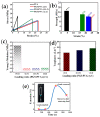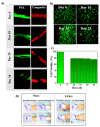A Composite Microfiber for Biodegradable Stretchable Electronics
- PMID: 34577680
- PMCID: PMC8468109
- DOI: 10.3390/mi12091036
A Composite Microfiber for Biodegradable Stretchable Electronics
Abstract
Biodegradable stretchable electronics have demonstrated great potential for future applications in stretchable electronics and can be resorbed, dissolved, and disintegrated in the environment. Most biodegradable electronic devices have used flexible biodegradable materials, which have limited conformality in wearable and implantable devices. Here, we report a biodegradable, biocompatible, and stretchable composite microfiber of poly(glycerol sebacate) (PGS) and polyvinyl alcohol (PVA) for transient stretchable device applications. Compositing high-strength PVA with stretchable and biodegradable PGS with poor processability, formability, and mechanical strength overcomes the limits of pure PGS. As an application, the stretchable microfiber-based strain sensor developed by the incorporation of Au nanoparticles (AuNPs) into a composite microfiber showed stable current response under cyclic and dynamic stretching at 30% strain. The sensor also showed the ability to monitor the strain produced by tapping, bending, and stretching of the finger, knee, and esophagus. The biodegradable and stretchable composite materials of PGS with additive PVA have great potential for use in transient and environmentally friendly stretchable electronics with reduced environmental footprint.
Keywords: biodegradable; microfiber; poly(glycerol sebacate); poly(vinyl alcohol); stretchable electronics; transient electronics.
Conflict of interest statement
The authors declare no conflict of interest.
Figures




References
-
- Souri H., Banerjee H., Jusufi A., Radacsi N., Stokes A.A., Park I., Sitti M., Amjadi M. Wearable and Stretchable Strain Sensors: Materials, Sensing Mechanisms, and Applications. Adv. Intell. Syst. 2020;2:2000039. doi: 10.1002/aisy.202000039. - DOI
-
- Wan S., Zhu Z., Yin K., Su S., Bi H., Xu T., Zhang H., Shi Z., He L., Sun L. A Highly Skin-Conformal and Biodegradable Graphene-Based Strain Sensor. Small Methods. 2018;2:1700374. doi: 10.1002/smtd.201700374. - DOI
-
- Trung T.Q., Duy L.T., Ramasundaram S., Lee N.E. Transparent, Stretchable, and Rapid-Response Humidity Sensor for Body-Attachable Wearable Electronics. Nano Res. 2017;10:2021–2033. doi: 10.1007/s12274-016-1389-y. - DOI
-
- Amjadi M., Kyung K.U., Park I., Sitti M. Stretchable, Skin-Mountable, and Wearable Strain Sensors and Their Potential Applications: A Review. Adv. Funct. Mater. 2016;26:1678–1698. doi: 10.1002/adfm.201504755. - DOI
-
- Zhang Q., Liu X., Duan L., Gao G. Ultra-Stretchable Wearable Strain Sensors Based on Skin-Inspired Adhesive, Tough and Conductive Hydrogels. Chem. Eng. J. 2019;365:10–19. doi: 10.1016/j.cej.2019.02.014. - DOI
Grants and funding
LinkOut - more resources
Full Text Sources
Research Materials
Miscellaneous

